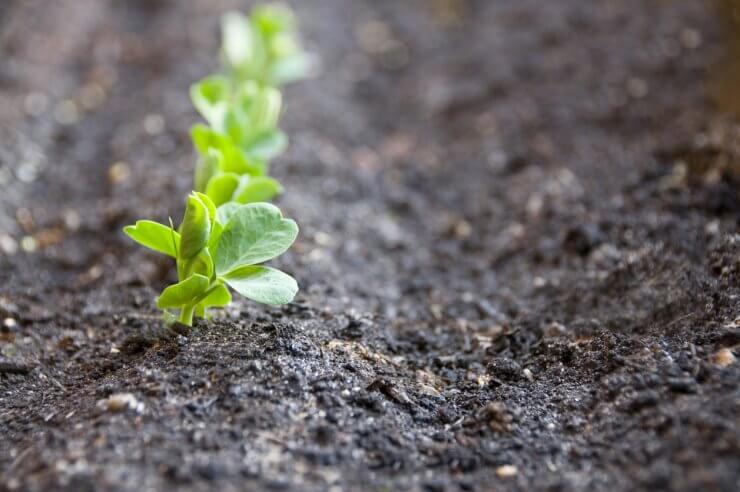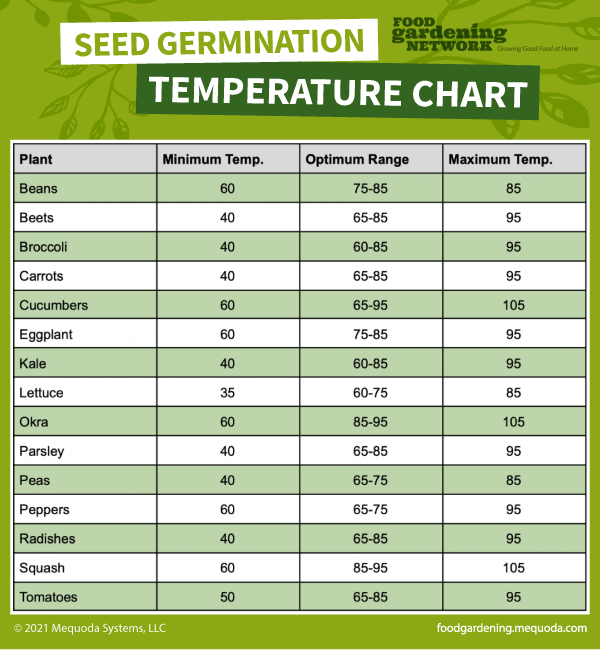FREEBIE: Printable Seed Germination Temperature Chart—get FREE access right now!
The Beginner Gardener’s Seed Germination Temperature Chart
Use this seed germination temperature chart to give your favorite herb and vegetable seeds a successful start.

Seeds are a marvelous thing. Call me easily amused, but it’s just astounding to me that a handful of seeds can give us an entire garden full of squash, peas, tomatoes, beans, cucumbers, broccoli, and so much more. And all of that – everything that ends up on your plate – starts with those tiny little seeds. Personally, I find a seed germination temperature chart to be helpful in making this all happen.
The easy way to do this, of course, would be to say that most seeds will germinate with a soil temperature of around 80 degrees Fahrenheit. Of course, that’s assuming optimal conditions. I’m sure I don’t need to tell you that seeds will germinate and thrive at different temperatures, though. Your cool weather crops probably aren’t going to be so fortunate as to have soil flown in directly from a leisurely tropical vacation so their seeds can bask in cozy soil.
Let’s make this easy on ourselves, shall we? Let’s take a look at different types of seeds and plants, the equipment you need, and a few tricks for helping your seeds along. Once we do that, the seed germination temperature chart will hopefully be more helpful.

Cooler and warmer: Getting your seeds ready
Whether you’re starting your seeds indoors or sowing them directly into the soil outdoors, using a thermometer is the only way you can really know how warm or cool your soil is. A soil thermometer doesn’t need to be anything fancy. There are quite a few available in the $15 range. Record the morning and evening temperatures for a few days to get your average temperature. There may not be a big difference if you start seeds indoors, but outdoor temperatures can vary widely.
If you’re sowing seeds outdoors, you can try a few tricks to increase the average soil temperature. One classic approach is to cover the soil in black sheeting several weeks before you want to put seeds in the ground.
Be aware, however, that early-season crops, such as broccoli, will germinate at lower minimum temperatures than warm-weather crops like squash or peppers. But we can explore that more in the seed germination temperature chart below.
Your one-stop seed germination temperature chart for beginners
When you look at this seed germination temperature chart, you’ll see there’s a minimum and maximum temperature, as well as an optimal temperature range. The information is from the University of California, Division of Agriculture and Natural Resources.
One interesting thing to consider is that the closer the soil is to the optimum temperature, the more quickly seeds will germinate. So even though tomatoes, for example, will germinate at temperatures as low as 50 degrees, it will take about six weeks. With temperatures in the optimal range, tomato seeds will germinate in just over five days. Once you pass that point and move into the maximum temperatures, however, the germination time increases again. That’s not true with all vegetables, but it is fascinating, and it just goes to show how different conditions can really impact the success of your garden.

That’s hopefully enough to get you started. Luckily, nature can be pretty forgiving, so don’t stress too much about getting everything perfect. After all, gardening is supposed to be relaxing!
How in-depth do you get with seed germination and soil temperatures? I’d love to read about your process in the comments.
Note: Food Gardening Network contains links to affiliate websites including Amazon and Rakuten Affiliate Network and we may receive a commission for any eligible purchases made by you through links on this page.
Sincerely,

Amanda MacArthur,
Senior Editor & Producer
Food Gardening Network




Please remove me from your email list.
Do you have chart in Celcius?
Please take me off of this site…list.